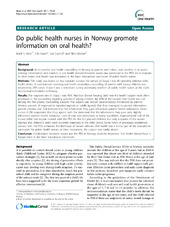| dc.contributor.author | Skeie, Marit Slåttelid | en_US |
| dc.contributor.author | Skaret, Erik | en_US |
| dc.contributor.author | Espelid, Ivar | en_US |
| dc.contributor.author | Misvær, Nina | en_US |
| dc.date.accessioned | 2012-01-24T09:34:33Z | |
| dc.date.available | 2012-01-24T09:34:33Z | |
| dc.date.issued | 2011-09-18 | eng |
| dc.Published | BMC Oral Health 2011, 11:23 | en |
| dc.identifier.issn | 1472-6831 | |
| dc.identifier.uri | https://hdl.handle.net/1956/5513 | |
| dc.description.abstract | Background: (i) to describe oral health counselling in Norway to parents with infants and toddlers, ii) to assess existing collaboration and routines in oral health matters between nurses and personnel in the PDS, iii) to evaluate to what extent oral health was integrated in the basic educational curriculum of public health nurses. Methods: This study was based on two separate surveys: the sample of Study I was 98 randomly selected child health clinics. A questionnaire covering oral health promotion counselling of parents with young children was returned by 259 nurses. Study II was a telephone survey addressing teachers of public health nurses at the eight educational institutions in Norway. Results: The response rate in Study I was 45%. Nutrition (breast feeding, diet) was the health subject most often prioritized in the counselling targeting parents of young children (by 60% of the nurses). Oral health was not among the first priority counselling subjects. The subject was seldom spontaneously mentioned by parents. Seventy percent of respondents reported (agreed or totally agreed) that they managed to provide information parents needed and 72% believed that the information they gave influenced parents’ health behaviours. Seven nurses (5.2%) responded that they agreed with the statement that the information they gave only slightly influenced parents’ health behaviour. Lack of time was mentioned as being a problem. Approximately half of the nurses (48%) had regular contact with the PDS for the 0-3 year-old children, but only a quarter of the nurses claimed that children’s teeth were routinely examined at the child clinics. Some forms of previously established contact with the PDS enhanced the likelihood of nurses’ referrals. Oral health was a minor part of the educational curriculum for public health nurses; at three institutions, the subject was totally absent. Conclusion: Collaboration between nurses and the PDS in Norway could be improved. Oral health should have a bigger place in the basic educational curriculum. | en_US |
| dc.language.iso | eng | eng |
| dc.publisher | BioMed Central | eng |
| dc.rights | Attribution CC BY | eng |
| dc.rights.uri | http://creativecommons.org/licenses/by/2.0/ | eng |
| dc.title | Do public health nurses in Norway promote information on oral health? | en_US |
| dc.type | Peer reviewed | |
| dc.type | Journal article | |
| dc.description.version | publishedVersion | en_US |
| dc.rights.holder | Copyright 2011 Skeie et al; licensee BioMed Central Ltd. | |
| dc.identifier.doi | https://doi.org/10.1186/1472-6831-11-23 | |
| dc.identifier.cristin | 840853 | |
| dc.subject.nsi | VDP::Medical disciplines: 700::Clinical dentistry disciplines: 830::Oral medicine: 835 | eng |
| dc.subject.nsi | VDP::Medical disciplines: 700::Health sciences: 800::Health service and health administration research: 806 | eng |

